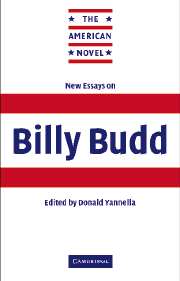Book contents
- Frontmatter
- Contents
- Series Editor's Preface
- List of illustrations
- Notes on contributors
- Introduction
- 1 Billy Budd and American labor unrest: the case for striking back
- 2 Religion, myth, and meaning in the art of Billy Budd, Sailor
- 3 Old man Melville: the rose and the cross
- 4 Melville's indirection: Billy Budd, the genetic text, and “the deadly space between”
- Select bibliography
- Index
1 - Billy Budd and American labor unrest: the case for striking back
Published online by Cambridge University Press: 02 December 2009
- Frontmatter
- Contents
- Series Editor's Preface
- List of illustrations
- Notes on contributors
- Introduction
- 1 Billy Budd and American labor unrest: the case for striking back
- 2 Religion, myth, and meaning in the art of Billy Budd, Sailor
- 3 Old man Melville: the rose and the cross
- 4 Melville's indirection: Billy Budd, the genetic text, and “the deadly space between”
- Select bibliography
- Index
Summary
It seems an inconsistency to assert unconditional democracy in all things, and yet confess a dislike to all mankind – in the mass. But not so.
– melville, Letter to Nathaniel Hawthorne (June 1851)“The times are revolutionary,” declared John Swinton, the former editor of the New York Sun, and his fellow New Yorker Herman Melville surely agreed, for the times were the mid-1880s and the United States was experiencing one of the most sustained periods of violent labor unrest in its history. The French revolution of 1871 marked the beginning of three decades of bitter class struggle in America as workers, influenced by the worldwide socialist movement, struck for better wages, shorter hours, and improved working conditions. The vast influx of eight million immigrants into the United States during 1870–90 led to a cycle of wage-cutting, union organization, strikes, and reaction. During the peak years of upheaval, 1877, 1886, and 1892–93, tens of thousands of strikes, involving hundreds of thousands of workers, occurred in a number of industries across the country. Owners, employers, and their representatives in city, state, and federal governments called the strikes “insurrections,” linked them to the “Paris Commune,” and denounced the strikers as “anarchists,” “communists,” “Reds,” “foreign agitators,” and “bomb-throwers.” Meanwhile, urban newspapers and magazines depicted union workers as dark, unshaven men arriving from abroad, armed with swords, bombs, rifles, and cannon.
- Type
- Chapter
- Information
- New Essays on Billy Budd , pp. 21 - 48Publisher: Cambridge University PressPrint publication year: 2002
- 21
- Cited by



